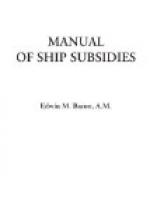The effect of these laws was to stimulate overproduction. The Nippon Yusen Kaisha ordered eighteen large freight steamers aggregating 88,000 tons. Other companies doubled and trebled their fleets.[FD] One result of the overproduction was the forcing down of freights. This, together with the business depression of 1898-99, brought losses to the shipping companies despite the large subsidies. The rapidly increasing amounts of the subsidies, too, were giving the Government concern. From a total of 1,027,275 yen in 1896 the sum expended annually had grown by 1899 to 5,846,956 yen. The total paid between 1896 and 1899 had amounted to 13,133,440 yen, about $6,566,720.[FD]
Accordingly, in 1899 (March), a law was enacted modifying the system. The navigation bounties on foreign-built ships were reduced by half, while the subventions to the postal lines were fixed at certain yearly sums. A law of 1900 (February 23) extended the postal services. Under these laws the postal subventions reached a total of about 5,647,811 yen ($2,823,905) a year. Of this total the Nippon Yusen Kaisha’s was the lion’s share,—4,299,861 yen, about $2,149,930.[FD]
After the passage of these laws the various companies further increased their tonnage, but the merchant marine grew more wholesomely for a while. In 1902 the total tonnage had reached 934,000 tons, and the Japanese mercantile fleet had risen to the position of eighth in the world in point of tonnage, whereas in 1892 it was only thirteenth.[FE] In 1907 the United States consul at Yokohama wrote: “The building of ships of over ten thousand tons in Japanese yards is now quite common.... The war [with Russia] has given a great impetus to the shipbuilding and dock-yard industry which has made remarkable progress during the last few years."[FF]




